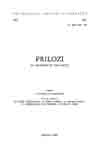Popis bosanske vojske pred bitku na Mohaču 1526. godine
The register of the bosnian army of the eve of the Mohač battle of 1526
Author(s): Ahmed S. AličićSubject(s): History
Published by: Orijentalni Institut u Sarajevu
Summary/Abstract: This work makes public the register of the army from the Bosnian Sanjak on the eve of the Mohač battle of 1526. The original of the register (defter) is kept at the Archives of the Topkapu Museum of Istanbul under the number Ar. D. 4175, and the microfilm and photocopies at the Academy of Sciences and Arts of Bosnia and Herzegovina. The register has not been preserved in entirety. Only 17 pages have been saved, which represents a little over a half of the whole defter. This is the oldest register of this kind known so far (the so-called yoklama defter) which relates to Bosnia. The date of the register has not been preserved, so it had to be established by an indirect method. Some persons mentioned in the defter are known to have been among closest associates of Gazi Husrev-beg, which points to the fact that Gazi Husrev-beg was then governor (sanjakbeg) of Bosnia. Among these the names of Kara Osman (beg) and Murat-vojvoda, the well-known Murat-beg Tardić, stand out. In addition, two regular registers of Bosnia, from 1516 and 1528; confirm that this register appeared in the time span between these two years; also, it is known that in that period only one imperial campaign was led, and that was the Mohač one of 1526. Accordingly, the register in question could originate only then. Apart from this, the territory of the Bosnian Sanjak which is included in the register supports the opinion that this was the time of the Mohač battle. According to this defter, 2990 soldiers from Bosnia had to go to the war, not counting those who stayed behind to defend Bosnia, who were 126 in number. The register opens a possibility of several lines of study: structure of the Ottoman army and population, participation of our people in that army and their social and economic position; manner of going to war; ranks and titles of various categories of soldiers and commanding officers; identification of a large number of begs and vojvodas who played an important part in the political and social life of Bosnia; islamization of Bosnia, etc. Especially interesting is the fact that a majority of registered persons were marked by the name of their place of origin; thus we encounter such designations as Croatian, Bosnia and so on. In addition, the persons designated as Croatian appear regularly with the designation of Gulam. The register offers an insight into the role of the Wallachian princes in the Bosnia under Ottoman rule, who acconding to this register were given the task of defending Bosnia; 47 of them were listed. Of special interest is the institution of the vojvoda, which was obviously very important at the time. Among the feudal lords listed, the members of the Malkočević family are especially prominent - thus this register offers a possibility of their closer identification. Finally, as for the question of islamization of Bosnia, we can conclude on the basis of this defter that that process was faster than has been thought so far.
Journal: Prilozi za orijentalnu filologiju
- Issue Year: 1976
- Issue No: 25
- Page Range: 171-202
- Page Count: 32
- Language: Bosnian

